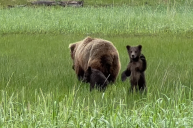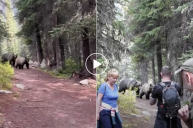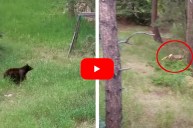The rare white grizzly bear known as Nakoda died over the weekend after a vehicle collision on the Trans-Canada Highway in Yoho National Park. The accident happened about 12 hours after her cubs were killed in a separate crash on the same road.
Parks Canada officials say wildlife managers witnessed the collision on the evening of June 6. At the time, they were trying to encourage Nakoda to get away from the roadside, but a train startled her and she ran into the road in front of two vehicles. One swerved, but the other couldn't react in time and hit her.
Following the collision, they saw Nakoda climb over a fence and run into the forest. Initially, they thought she would recover because her only visible injury was a slight limp. "She was able to climb the fence and run into the forest after her collision and wildlife specialists were hopeful she would be able to make a recovery," officials said.
But they picked up a mortality signal on Nakoda's tracking collar on June 8 and found her body. They think she died of internal injuries due to the collision, but the cause of death will remain unknown. Officials say removing her body from the backcountry "was not feasible." Plus, park policy requires staff to leave animal carcasses on the landscape when possible.
What happened to Nakoda's cubs
Park officials say they started monitoring Nakoda and her two cubs' movements after reports of a fence intrusion on June 5. While they took action by hazing the bears back behind the fence and making repairs to the fence, the animals returned sometime the next morning.
Then, park officials received a call about a vehicle hitting Nakoda's cubs on June 6 at around 5:15 a.m. When authorities arrived on the scene, they found the cubs dead on the road and Nakoda lingering about. So they hazed the bear back behind the fence.
Officials say there were a few reasons why Nakoda and her cubs spent so much time near the roadway. "Wildlife specialists had observed that (Nakoda) was very driven to spend time along the highway," they said. "Bears will return to areas they know and to areas with high-value habitat."

Officials say they relocated the rare white grizzly bear three times and even electrified the fence, but she kept returning to the area. Credit: Parks Canada
Plus, Nakoda had become habituated to humans due to the overwhelming public interest in her. As a celebrity of sorts, many visitors and motorists traveled to the park to see the rare white bear.
Nakoda gained fame after pictures of her inside Canada's Banff National Park emerged online. Then, in 2020, the Bow Valley Network, a social media hub for outdoor destinations, hosted a fan vote to name her. While scientists labeled her Grizzly Bear 178, the people called her Nakoda.
So the collisions that killed Nakoda and her cubs happened because of a combination of bears returning to a reliable source of food and tourists.
Why they didn't relocate Nakoda
Officials say in the two years wildlife teams managed Nakoda, they had collared her, relocated her three times, and even electrified the fence, but she kept returning to the area. However, they said the electrified had some success discouraging the bear.
After park staff electrified the fence in 2023, Nakoda was not seen or tracked along the road for a year. In fact, she had spent most of the summer in the backcountry and away from areas of "high human use."
But in May, they observed Nakoda and her cubs along the highway. Officials say relocating Nakoda and her cubs "was not considered an option" because they only spent a short periods near the highway and the risk of physically moving them was "considered too great."
Instead, park officials opted to implement a "No-Stopping" rule and a speed reduction for the 10-kilometer stretch the bears ranged on.




